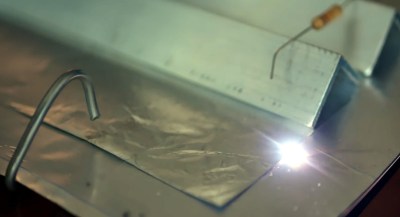The Devil is in the Details For This Open Air Laser

Normally, we think of lasers as pretty complex and fairly intimidating devices: big glass tubes filled with gas, carefully aligned mirrors, cooling water to keep the whole thing from melting itself, that sort of thing. Let’s not even get started on the black magic happening inside of a solid state laser. But as [Jay Bowles] shows in his latest Plasma Channel video, building a laser from scratch isn’t actually as difficult as you might think. Though it’s certainly not easy, either.
The transversely excited atmospheric (TEA) laser in question uses high voltage passed across a a pair of parallel electrodes to excite the nitrogen in the air at standard atmospheric pressure, so there’s no need for a tube and you don’t have to pull a vacuum. The setup shakes so many UV photons out of the nitrogen that it doesn’t even need any mirrors. In fact, you should be able to get almost all the parts for a TEA laser from the hardware store. For example, the hexagonal electrodes [Jay] ends up using are actually 8 mm hex keys with the ends cut off.

Of course, you’ll need a fair bit of power to get your homebrew laser going. Luckily, [Jay] has been performing most of his recent experiments with an affordable and easy to build high voltage supply made from a TV flyback transformer. He’s already produced a step-by-step video on sourcing the appropriate components and get everything assembled, which is really a must watch if you’re interested in doing HV experimentation on a budget.
But while it might be easy to build a TEA laser in principle, actually getting it to fire reliably is another story entirely. After some fiddling and a few false starts, [Jay] got in contact with noted madman laser enthusiast [StyroPyro], who gave him some advice based on his own TEA laser project. It ended up being a great example of how finicky these devices are, as his build was only a few slight adjustments away from producing a solid beam. Honestly, who would have thought to sand the hex keys with 500 grit paper?
We’ve seen a number of TEA lasers built over the years, ranging from robust professional looking units to delightfully whimsical hand-cranked versions, (from our own [Steven Dufresne]!) but the simple elegance of the one [Jay] has put together makes it the one we’d be most likely to replicate on our own kitchen table.
Post a Comment